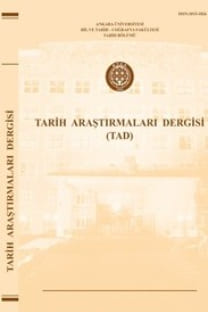Anadolu’da Bulunan Yeni Asurca Belgeler
M.Ö.1000-612 yılları arası Yeni Asur Dönemi olarak adlandırılmıştır. Bu dönemde Asur Devleti, başta ticarî faaliyetleri ile, buna bağlı olarak da, siyasal ve kültürel açıdan Anadolu tarihini etkilemiştir. Biz bu etkileri, günümüze ulaşmış Yeni Asurca mektuplar, kitabeler ve kral yıllıkları sayesinde aydınlatabiliyoruz. Bu çalışmada Yeni Asurca Belgeler ve Anadolu’daki buluntu merkezleri, çivi yazılı belgeler ve arkeolojik bulgular doğrultusunda araştırılmıştır. Bu merkezlerden elde edilen tablet ve yazıtlar konuları açısından incelenmiş, bir tablo yardımıyla sınıflandırılmıştır. Bu tabloda Yeni Asur buluntu merkezleri, eski adları, buluntu sayısı ve bibliyografyalarıyla birlikte sunulmuştur. Yine bu tablodan yola çıkarak, bahsi geçen merkezlerin lokalizasyonunu netleştirmek adına, bir harita çalışması gerçekleştirilmiştir
Anahtar Kelimeler:
Yeni Asurca Belgeler, Huzirina, Nabula
Neo-Assyrian Documend Found in Anatolia
It can be said that the period between BC. 1000-612 has been named as New Assyrian Period. In this period, State of Assur has been effected Anatolian history with respect to trading chiefly, politically and culturaly aspect on it. We highlighted these effects, by means of letters, inscriptions and king annuals. On this study, the document of New Assyrian and excavation centres in Anatolia was investigated in directional of cuneiform documents and archeological findings. Documents and inscriptions obtained from these areas were examined and classified with the help of the table. In this table, excavation centres were submitted with the old names of these, the number of findings and bibliographies. By benefited from the table, in order to be cleared the location of mentioned centres, a workmap was carried out.
Keywords:
Documents of New Assyrian, Huzirina, Nabula.,
___
- Gökçe, N - Lloyd,S. (1952) “Sultantepe”, Anatolian Studies, BIAA, Ankara.
- Gurney, O.R.- Finkelstein, J. (1957) The Sultantepe Tablets I , TTK, Ankara.
- Gurney, O.R.- Hulin,P., (1964) The Sultantepe Tablets II, TTK,Ankara.
- Luckenbil, D.D. (1968) Ancient Records of Assyria and Babylonia, I-II, New York.
- Grayson, A. (1987) “Assyrian Expansion Into Anatolia In The Sargonid Age”, Uluslararası Assyriyoloji Kongresi, 6-10/ VII.
- Luckenbill, D.D. (1968) Ancient Records of Assyria and Babylonia, I- II, New York.
- Köroğlu, K. (1998) Üçtepe I / Üçtepe ve Çevresinin Yeni Asur Dönemi Tarihi Coğrafyası, TTK. Ankara.
- Matney. T and MacGinnis. (2002) Anatolica, Berlin.
- Parpola, S. (2006) 'Cuneiform Texts From Ziyaret Tepe (Ancient Tushan) 2002-2003' State Archives of Assyria Bulletin 16.
- Donbaz, V. (1988) “Some Neo-Assyrian Contracts from Girnavaz and Vicinity”, SAAB 11/1, 1-30.
- Erkanal, H. (1985) Girnavaz Kazı Sonuçları Toplantısı VII, TTK, Ankara.
- Hawkins. J. (1969) “The Babil Stele of Asurnasirpal”, Ant.St.XIX.
- Kessler. K. (1980) Undersuchungen zur historischen Topographie Nordmesopotamiens, Weisbaden.
- Lehman-Haupt (1901) “Der Tigris-Tunnel”, ZfE 33, Verh.
- Olmstead. A.T. (1964) History of Assyria, Chicago and London.
- Radner, K. (2004) Das Mittelassyrische Tontafelarchiv Von Giricano/Dunu- ša- uzibi Excavations at Giricano I., Subartu14, Turnhout.
- Radner, K. - Schachner, A. (2001) From Tušhan to Amedi Topographical Question Concerning the UpperTigris Region in the Assyrian Period. In Salvage Project of The Archaeology Heritage of the Ilısu and Carchemish DamReservoirsActivities in Ankara: Middle East Technical University.
- Szuchman, J.J. (2007) Ziyarettepe / Tušhan / Upper Tigris, London.
- Luckenbil, D.D (1968) Ancient Records of Assyria and Babylonia, NewYork.
- Köroğlu, K. (1998) Üçtepe I / Üçtepe ve Çevresinin Yeni Asur Dönemi Tarihi Coğrafyası. TTK. Ankara.
- Smith. S. (1938) Assyrian Sculptures in the British Museum from Shalmaneser III to Sennacherib, London.
- Szuchman, J. J. (2007) Ziyarettepe / Tušhan / Upper Tigris, California University. London.
- Donbaz, V. (1990) “III.Adad-nerari’ye ait yazıtlı stel”, “Two Neo-Assyrian Stelae in the Antakya and Kahramanmaraş Museums”, Toronto.
- Hawkins, J. (1995) “The Political Geography of North Suriye and South-East Anatolia in the Neo-Assyrian Period”, London.
- Luckenbill, D.D.(1968) Ancient Records of Assyria and Babylonia, I-II, New York.
- Rost, P. (1893) Noach Einmal Das Bit-Hilani und Die Assyrische Saule, Leipzing.
- Gökçek, G. (2005) “Kahramanmaraş’ta Bulunmuş İki Yeni Asurca Tablet”, Anadolu Arşivleri, Ankara.
- Borger, R. (1956) “Die Inschriften Asarhaddons Königs von Assyrien” AfO, Beiheft 9, 1-133.
- Castellino, G.R. (1975) “Fragmento delgi Annali di Sargon II”, Ed.P.E.
- Pecorella, Malatya III. Rapporto Preliminare dele Campagne 1963-1868 II.Roma.
- Kınal, F. (1970-1974) “Eski Mezopotamya Tarihi”, A.Ü.D.T.C.F.D. VUI.
- Landsberger, B. (1948) “Sam’al” Karatepe Harabelerinin Keşfi ile İlgili Araştırmalar, Ankara.
- Postgate, J.N. (1977) Fifty Neo-Assyrian Legal Documents, British Institute of Arch. BIAA. Ankara.
- Umar, B. (1982) Türkiye Halkının İlkçağ Tarihi, E.Ü.Y, İzmir.
- Delaporte, L. (1940) Malatya, Arslantepe I, Paris.
- Hawkins, J.D. (1998) “Hittities and Assyrians at Melid” TTK, Ankara.
- Liverani, M. (1995) “ Neo-Assyrian Geography”, Roma.
- Luckenbill, D.D. (1968) Ancient Records of Assyria and Babylonia, I-II, New York.
- Donbaz, V. (1990) “III.Adad-nerari’ye ait yazıtlı stel”, “Two Neo-Assyrian Stelae in the Antakya and Kahramanmaraş Museums”, Toronto.
- Levine, L. (1972) Two Neo-Assyrian Stelae from Iran, BIAA, Ankara.
- Liverani, M. (1995) “ Neo-Assyrian Geography”, Roma.
- Hawkins, J.D. (1995)“The Political Geography of Nort Syria and South-East Anatolia in the Neo-Assyrian Period”, London.
- Taşyürek, A. (1975) “Antakya Kazıları”, Anatolian Studies./ 25.
- Luckenbill, D.D. (1968) Ancient Records of Assyria and Babylonia, I-II, New York.
- Liverani, M. (1995) “Neo-Assyrian Geography”, Roma.
- Hawkins, J.D. (1980) “Kargamiş”, RLA 5, 426-446.
- Hawkins, J.D. (1995)“The Political Geography of Nort Syria and South-East Anatolia in the Neo-Assyrian Period”, London.
- Szuchman, J. J. (2007) Ziyarettepe / Tušhan / Upper Tigris, California University. London.
- The Helsinki Atlas of the Near East in the Neo-Assyrian Period. BIAA.Ankara.
- ISSN: 1015-1826
- Yayın Aralığı: Yılda 2 Sayı
- Başlangıç: 1963
- Yayıncı: Levent KAYAPINAR
Sayıdaki Diğer Makaleler
Amurru Göçleri ve Amurruların Eski Önasya Tarihindeki Rolleri
Kitap Tanıtımı: Mehmet Ersan, Türkiye Selçuklu Devleti’nin Dağılışı
Anadolu’da Bulunan Yeni Asurca Belgeler
Şubat Devriminden Sonra Rusya’da İktidar Mücadelesi: Ekim Devrimi’ne Giden Yol
Macar Papaz Julian’in 1237 Tarihli Moğol Raporu
II. Sargon Devri Kaynakları Işığında Güney Anadolu ve Toros Dağları Bölgesi
Trabzon İmparatorluğu’nda Gemicilik
Çanakkale’de Yangınlar (1836–1866)
Milli Mücadele Yıllarında Muhalif ve Bolşevizm Karşıtı Bir Vali: Kapancızâde Hamit Bey
